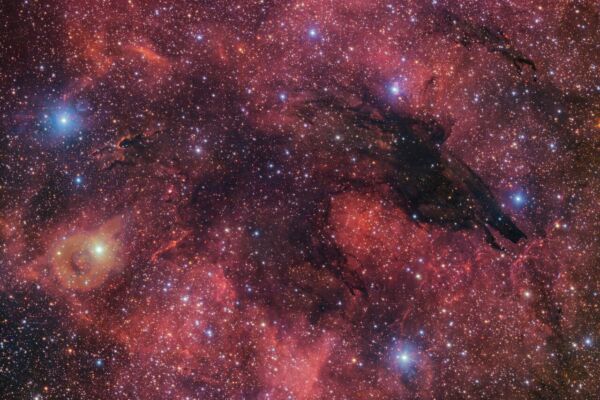The European Southern Observatory (ESO) recently released an image of a black nebula that resembles a black wolf in space, hence named the Dark Wolf Nebula.
According to a press release from ESO on October 31st, astronomers captured the high-resolution image of the Dark Wolf Nebula with a resolution of up to 283 million pixels using the VLT Survey Telescope located in Chile. The image creates an illusion of a wolf-like silhouette against the colorful cosmic background.
Located in the Scorpius constellation near the center of the Milky Way, the Dark Wolf Nebula is approximately 5,300 light-years away from Earth. Despite occupying an area in the sky equivalent to four full moons, it is actually a part of a larger nebula known as Gum 55.
Contrary to its dark appearance, the Dark Wolf Nebula is not devoid of substance. Dark nebulae are cold clouds composed of cosmic dust with densities sufficient to shield starlight and the light from celestial bodies behind them. As the name suggests, they do not emit visible light like other nebulae.
The dust particles within dark nebulae absorb visible light, allowing only longer-wavelength radiation like infrared light to pass through. Astronomers study these cold dust clouds because they often contain newly forming stars.
The spectacularly detailed image showcases how the Dark Wolf stands out in the glowing clouds behind it, creating a sharp contrast with the bright background. These colorful clouds are primarily composed of hydrogen and exhibit a slight reddish hue due to the intense ultraviolet radiation emitted by new stars within them.
Some dark nebulae, such as the Coalsack Nebula, are visible to the naked eye and played a crucial role in how the indigenous people of North America interpreted the sky. However, the Dark Wolf Nebula remains unseen without specialized equipment.
The VLT Survey Telescope is operated by the National Institute for Astrophysics in Italy and managed by ESO at the Paranal Observatory in the Atacama Desert, Chile. Equipped with a specially designed camera, the telescope surveys the southern sky in visible light.

